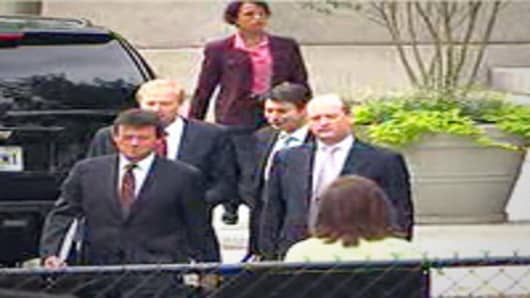Administration officials said the speech marked “an inflection point” in the nearly two-month-old crisis: the end of a phase in which BP tried and failed to stop the leak using the quickest available options, and the beginning of the “new reality” that plugging the leak could take months and the cleanup months or even years past that.
BP has outlined plans to deploy new equipment so that it can capture a minimum of 40,000 barrels a day by the end of June, and a minimum of 60,000 barrels a day by mid-July.
If the new range of flow estimates proves correct, and if BP is ultimately found guilty of gross negligence in actions it took that led to the Deepwater Horizon disaster, that would mean the company could be assessed fines of up to $258 million a day. Those fines could come on top of payments for cleanup costs and economic damage to Gulf Coast businesses.
Fearful that the spill could ultimately cost BP tens of billions of dollars, investors have driven the company’s market valuation down by 48 percent since the spill began, erasing $91 billion of shareholder value. BP shares rose more than 2 percent during regular trading on Tuesday, but then gave up all that gain and more in after-hours trading.
Mr. Obama has said all along that BP will pay for everything. People close to BP said that as asset-rich as the global oil giant is, its holdings are not so liquid that it can instantly set aside as many billions of dollars as the White House and leaders in Congress are seeking. Also being worked out are the terms by which BP would have to replenish the fund as it is drawn down.
BP officials are adamant that the company should not be liable for the lost wages of oil workers laid off because of the six-month moratorium that the Obama administration imposed on deepwater offshore drilling after the Deepwater Horizon explosion and fire. But Interior Secretary Ken Salazar and other administration officials repeatedly have cited idled oil workers as among those who could press claims.
Though BP has promised to cover all costs of the spill, the president and a number of lawmakers began pushing for the escrow account amid concerns about the company’s ability to meet its obligations over the long haul — or even survive the crisis intact.
To make sure that all claims are paid, the administration had demanded that BP set aside money to pay for future liabilities before paying dividends to shareholders, which now amount to about $10.5 billion a year.
Since the spill began, BP’s shares have lost almost half of their value. Shares trading closed Tuesday at $31.40, down from $60.48 on April 20. Over time, analyst say that a drop in BP’s market value could turn the company into a target for a takeover by Western rivals or even one of Asia’s national oil companies, although questions about the company’s financial liability for the spill would give pause to potential acquirers.
For the moment, however, with oil trading above $75 a barrel, the company has torrents of money flowing in and says it will be able to use that revenue to pay for the cleanup as well as many of the penalties it will face.
Last year, BP operations generated $27.7 billion in cash.
The company operates the biggest oil field in North America — Prudhoe Bay in Alaska’s North Slope. Its refineries in Texas City, Tex., and Whiting, Ind., are among the five largest in the country. Globally, the company had 63 billion barrels of resources at the end of 2009, including more than 18 billion barrels of proven reserves.
Last year, BP had about $26 billion in debt, giving it a debt-to-equity ratio of about 20 percent. The company has said that it could raise that ratio to 30 percent and still have an appropriate level of financial flexibility.
“Our asset base is strong and valuable,” BP said in a statement last week, adding that it had “significant capacity and flexibility in dealing with the cost of responding to the incident, the environmental remediation and the payment of legitimate claims.”


